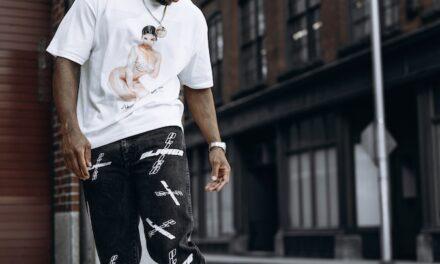In this article, discover the intriguing history of when the first pair of blue jeans made, from its French denim origins to Levi Strauss and beyond. Unearth rare facts and cultural significance worldwide.
Blue jeans have become an essential part of modern-day clothing, worn by people of all ages and backgrounds across the globe. The invention of blue jeans dates back to the 19th century and has a fascinating history that spans continents and cultures. Although they are ubiquitous today, little is known about their origins and evolution.
Denim fabric, which forms the foundation for blue jeans, has been around for centuries. It originated in Nimes, France, where it was known as Serge de Nimes.
The fabric was originally used for sails on ships due to its durability and strength. In 1853, Levi Strauss began importing denim fabric from France to make tents and wagon covers in San Francisco during the California Gold Rush.
However, it wasn’t until later that he realized its potential for making sturdy work pants. Today blue jeans are an iconic symbol of American culture and fashion worldwide.
They are worn by everyone from farmers to fashion models; from rock stars to royalty. They come in different styles, sizes, colors, shades – you name it! So how did this humble fabric become such a phenomenon? Let’s explore the history behind this wardrobe staple.
Brief History of Denim Fabric
As mentioned earlier denim fabric originated in Nimes France where it was known as Serge de Nimes or simply ‘denim.’ In the 16th century sailors from Genoa Italy started using this tough material for their sails as they discovered that it could withstand rough sea conditions much better than any other fabrics available at that time. In the early 19th century denim material was used extensively by laborers because of its durability under harsh conditions which made it ideal for workwear clothing like coveralls or overalls.
Over time denim found other uses such as military uniforms due to its sturdiness. Denim became popular during the California Gold Rush of 1849 when Levi Strauss, a German immigrant, began making trousers out of this fabric.
The Popularity of Blue Jeans Today
Blue jeans are now a fashion staple across the globe. They come in different styles and colors, and they are worn by people from all walks of life.
The popularity of blue jeans can be attributed to its versatility, comfort, durability and style. From workers to fashion icons, blue jeans have become an essential part of our wardrobe today.
The trend for designer jeans started in the 1970s which saw the introduction of higher priced denim garments that were more fashionable and stylish than traditional workwear pants. In recent times there has been a focus on sustainable denim production as it is an environmentally friendly fabric that lasts long and can be reused or repurposed in different ways.
The Mystery Surrounding the Origin of Blue Jeans
Although many people believe Levi Strauss invented blue jeans, there is some controversy surrounding their origin story. Some historians believe that similar pants were made before Levi Strauss by other people such as Jacob W. Davis who had also patented a design for reinforced work pants using copper rivets only two weeks before Levi Strauss did so with his partner Jacob Davis. Despite these debates around its origin story, one thing is certain – blue jeans have become an enduring symbol of American fashion culture worldwide.
The Early History of Denim Fabric
Origin of Denim Fabric in France
Denim fabric was first created in the French town of Nimes, hence the term “denim” which is a contraction of “de Nimes”. Originally called serge de Nimes, this sturdy fabric was made from cotton and wool fibers and had a distinctive twill weave. The use of indigo dye gave it a blue hue that would become synonymous with blue jeans.
Use of Denim Fabric for Workwear and Military Uniforms
The durability and strength of denim fabric made it ideal for workwear, especially for labor-intensive jobs like mining and farming. In fact, denim pants were worn by miners during the California Gold Rush in the mid-1800s. It was also used to make military uniforms during World War II due to its resilience and ability to withstand wear and tear.
Introduction of Denim Fabric to the United States
Denim fabric made its way across the Atlantic when it was imported to America in large quantities during the 19th century. It gained popularity among farmers, ranchers, and railroad workers due to its ruggedness. Levi Strauss, a German immigrant living in San Francisco at the time saw an opportunity to capitalize on this demand by creating durable work pants using denim fabric.
He teamed up with Nevada tailor Jacob Davis who suggested reinforcing key stress points on the pants using copper rivets. This partnership led to the creation of what we now know as blue jeans.
Denim fabric has a rich history dating back several hundred years in France before making its way across Europe into America where it became synonymous with hard labor and durability. From its early use as workwear and military uniforms to being an iconic piece of fashion today, denim has truly stood the test of time as a versatile material that continues to evolve with changing trends and technology.
The Birth of Blue Jeans
Levi Strauss’ Journey to America and His Business Ventures in San Francisco
The story of blue jeans began with an ambitious young man named Levi Strauss, who immigrated to the United States from Bavaria in 1847. After working as a peddler in New York for a few years, he headed west to San Francisco during the height of the California Gold Rush.
There, he established his own dry goods business and quickly gained a reputation for selling quality merchandise at fair prices. Strauss had a keen eye for opportunity and innovation.
In 1872, he received a letter from Jacob Davis, a tailor from Nevada who had come up with an idea to improve the durability of work pants by adding metal rivets at stress points. Davis lacked the funds to patent his invention, but he proposed that Strauss provide the capital in exchange for half ownership.
Collaboration with Jacob Davis to Create Durable Work Pants with Copper Rivets
Strauss saw potential in Davis’ idea and agreed to form a partnership. Together, they refined the design by using sturdy denim fabric instead of canvas and adding pockets reinforced with rivets as well. The first pair was made from “XX” denim which was woven exclusively for Levi’s at Amoskeag Mills in New Hampshire.
With this breakthrough innovation came great success; laborers began clamoring for these durable work pants that could withstand tough conditions such as mining or farming activities; it didn’t take long before they were commonly known as “waist overalls”. Although there is no definitive proof about whether or not it was indeed Jacob Davis who invented copper-riveted pants before collaborating with Levi Strauss, scholars agree that their partnership played an important role in popularizing this classic American workwear garment.
Patenting the Design and Manufacturing Process for “Waist Overalls” in 1873
Strauss and Davis recognized the potential of their new design and quickly filed for a patent on May 20th, 1873. The patent application described the pants as “improvement in fastening pocket-openings” and included detailed diagrams of the exact placement of the rivets. The patent was granted on May 20, 1873, laying down the foundation for one of the most iconic pieces of clothing in American history.
Soon after, Strauss began mass-producing these copper-riveted “waist overalls” under his own brand name – Levi Strauss & Co. Demand for his workwear grew rapidly as more businesses started looking for durable clothing solutions. By the early twentieth century, denim jeans had become a staple among laborers across America.
Levi Strauss and Jacob Davis’ collaboration resulted in an invention that would change fashion forever. Through their partnership and subsequent patenting process, they created a new product that would become an emblematic symbol of American culture; blue jeans have evolved over time but it is this original partnership that set them apart from other workwear options.
Impact and Evolution of Blue Jeans
Popularity among Miners, Cowboys, and Laborers
The durability and practicality of blue jeans quickly made them a hit among workers in the late 19th and early 20th century. Miners needed pants that could withstand rough conditions while cowboys needed durable pants for their daily work on the ranch. The versatility of blue jeans made them a popular choice among laborers as well.
As the garment became more popular, manufacturers began to design specific styles for trades such as railroad workers who required specialized pockets. During World War II, denim was in high demand for military uniforms.
This increased production led to lower prices and wider availability of denim clothing for the general public. By the end of the war, blue jeans had become an American staple.
Adoption by Youth Culture in 1950s-60s as a Symbol of Rebellion
In the 1950s and 60s, blue jeans began to take on a new meaning outside of just workwear. Teenagers began adopting them as a symbol of rebellion against their parents’ traditional values. Hollywood also played a role in promoting this trend with films like Rebel Without A Cause featuring James Dean wearing his signature denim jacket.
This adoption by youth culture led to widespread popularity among young people across America and eventually around the world. The simplicity and comfort of blue jeans resonated with youth culture who saw it as an expression of freedom.
Expansion into Fashion Industry with Designer Jeans and Customized Styles
In the 1970s, designer jeans began to emerge on the fashion scene thanks to brands like Calvin Klein, Gloria Vanderbilt, and Jordache who added embellishments such as embroidery or rhinestones to their designs. Customization became popular too with people experimenting with bleach or distressing techniques on their own personal pairs of jeans.
This trend led to a wide variety of styles including high-waisted, skinny, flared, and boot-cut. Today, blue jeans are worn by people of all ages and backgrounds around the world.
They have been embraced by the fashion industry as a timeless classic that can be dressed up or down depending on the occasion. The evolution of blue jeans from workwear to fashion staple is a testament to their versatility and enduring popularity.
Rarely Known Details about Blue Jeans
Different shades and hues beyond classic blue
While blue may be the most popular color associated with denim, there are actually many different shades and hues of denim available. From light wash to dark wash, black denim to white denim, and even colored denim in shades of red, green, and yellow.
The variety of colors allows for customization and personalization of the beloved wardrobe staple. It also allows for jeans to be dressed up or down depending on the occasion.
In addition to dyeing techniques, finishes such as distressing, sandblasting or acid-washing can give jeans different textures and a worn-in look. Each finish gives a unique character to a pair of jeans making them an extension of the individual wearing them.
Unique features such as selvedge edges, hidden rivets, and chain stitching
Beyond color options, denim jeans come with various design details that contribute to their durability and longevity. Selvedge edges are self-finished woven edges that prevent fraying over time.
They can be seen on the inside seam of some jeans lending an authentic look. Hidden rivets reinforce stress points like pockets where frequent use causes wear-and-tear over time; they help ensure that pockets stay in place.
Chain stitching is often used in hemming because it provides additional flexibility compared to lockstitch sewing machines commonly used today. Chain stitch hemming is a signifier of quality craftsmanship in jeans production – although it is more expensive than other methods – because it uses special machines operated by highly skilled workers.
Cultural significance around the world
Blue jeans have transformed from simple workwear pants into cultural icons around the globe. In America they’ve been incorporated into our casual wardrobe staples while other cultures view them as an aspirational high end fashion item – including luxury designers creating their own versions of the classic. In Japan, for example, selvedge denim has become a sought-after material with the country’s manufacturers and collectors using it not just for jeans but for high-end fashion items like jackets and bags as well.
The cultural significance of blue jeans is also reflected in their associations with particular subcultures over time. For example, ’70s punk fans wore ripped skinny jeans, while ’90s grunge aficionados preferred oversized, slouchy styles.
The versatility of denim allows it to be manipulated to fit a range of styles and aesthetics over time – from casual to chic or even avant-garde depending on the audience’s preferences. Blue jeans are more than just comfortable pants – they have become an integral part of global fashion culture.
Beyond their classic blue color and sturdy build, the variety of designs available offers an opportunity for personal expression and style experimentation. Whether you prefer them as skinny or wide-leg, dark wash or light wash there’s no denying that blue jeans are here to stay as one of fashion’s most loved icons.
Conclusion
The Timeless Appeal of Blue Jeans
From durable workwear to a global fashion staple, blue jeans have come a long way since their humble beginnings in the late 1800s. The enduring popularity of denim speaks to its versatility and practicality, as well as its cultural significance as a symbol of individualism and rebellion. Though styles may change and new trends emerge, it seems unlikely that blue jeans will ever go out of fashion completely.
The Legacy of Levi Strauss
The story behind the creation of blue jeans is just one example of how innovation and entrepreneurship can shape history. The pioneering spirit and business savvy of Levi Strauss helped transform work pants into an iconic American garment, while also setting a precedent for ethical manufacturing practices and corporate responsibility. Today, the company that bears his name continues to evolve with the times, adapting to new technologies and consumer demands without losing sight of its roots.
The Future of Denim
As our society becomes more conscious about sustainability and environmental impact, the fashion industry is coming under scrutiny for its wastefulness and contribution to pollution. Fortunately, there are efforts underway to make denim production more eco-friendly by using recycled materials or organic cotton, reducing water usage during manufacturing processes, or treating wastewater before releasing it into rivers or oceans.
By embracing innovative solutions like these, we can help ensure that future generations will be able to enjoy the timeless appeal of blue jeans without harming our planet in the process. When was the first pair of blue jeans made is not just a question about history but also about how innovation has shaped culture in America.
The story behind this iconic garment serves as a reminder that sometimes life’s biggest breakthroughs come from unexpected places – like an immigrant entrepreneur who arrived in California during the gold rush era – but they can have lasting impact on generations after them. As for blue jeans themselves, they will continue to remain a beloved fashion staple for years to come.










